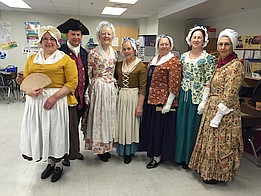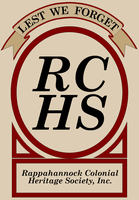ATTIRE FOR MEN
Fabrics and Colors
Fabric was imported to the colonies through England, which made it costly. Most clothing of the day was wool and linen though some cotton was worn. Satin and silk were worn by the “upper class” but could have been worn by lesser persons. It was inventoried as part of estates and actually willed to individuals. There was also trade in second-hand clothing. Popular colors for men included black, blue, and lead (gray) though they also wore bright colors and designs. Clothing imitated nature in that the male could have brighter plumage than the female.
Shirt
The man’s all -purpose garment. They were made very long to “tuck up” as underwear. This choice is up to you. This would have also been used to sleep in. Most shirts that were inventoried for wills were made of white linen though “checks” were worn by the lower classes. Collars were not big. A “tie”, ruffle, or stock was commonly worn around the neck. The ruffle at the neck may have been loosely attached so it could be removed for cleaning without washing the whole shirt. The shirt itself could be a “coarse” material while the collar and cuffs were “finer.” A proper gentleman would not be seen in his shirtsleeves so only the collar and cuffs would have been seen under his coat.
Breeches
“Trousers” of the 18th century. These had a “fall front” (buttons and flaps) and more commonly were buttoned at the knee. The seat was extremely large because the leg was form fitting so the man could put his “best foot forward.” It created ease in the seat so one could sit down. Breeches might have a pocket for a time-piece or might not have pockets, as we know them today.
Waistcoat
This is the 18th century equivalent of the 21st century vest. Depending on the particular year some waistcoat styles were longer in the front than the back. Other styles had lacing in the back to accommodate “growth” since fabric was so expensive. The front panels would have been the “good” material while the back was more than likely linen, which would have served as the lining for the front panels as well. Again, a proper gentleman would have worn a coat so the vest back would not have been seen.
Frock Coat
This is the “suit coat” of the 18th century. They would have been made more often than not out of linen or wool. Some re-enactors use cotton today. (Ask before you buy). The “tail” style/size (back of the coat) may vary, as the cuff size did also, according to the early 18th or late 18th century. Most buttons seem to have been fabric covered. The frock coat has many buttons down the front, but they were not made to be fastened.
Cocked Hat
The 19th century term is “tricorn” but during the 18th century, cocked hat would be the correct term. Traditionally black or brown wool felt – or beaver if you could afford it – trimmed with wool braid. Straw cocked hats are also appropriate for summer wear. Hats may also have a cockade – a type of rosette made out of ribbon. Please avoid the “costume” type hat.
Stock
Worn around the neck.
Stockings
Think of these as long socks – not stockings as women would wear today. They come over the knee under the leg of the breeches. They can be held up with leather garters below the knee, or something of your choice under the breeches the leg. The most common color seems to be white though other colors were worn. They may have been “clocked,” which is a design that starts at the ankle and goes up the leg a few inches. Most stockings of the day would have been knit of wool. Some re-enactors wear cotton today. For RCHS formal and evening occasions wear white only.
Shoes
Men’s shoes were basic in form. They had latchets (buckles attached to this) and a tongue which could be big or small in size. Most were of black leather and, depending on the station of the wearer, were either smooth leather for higher class or rough leather for lower class. The upper class would have buckles – silver, brass, or “paste.” The lower class shoe could have buckles but commonly would have been tied with leather laces, or linen strips. Men of the gentry class might wear leather mules (slippers) in their home. These might be brown or red leather. The man’s shoe is an important part of the attire because they are so visible. There were riding boots but they are for a specific impression/occasion.

